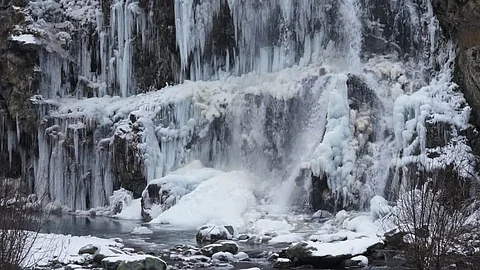

As winter tightens its grip on Kashmir, the region enters the cold embrace of Chillai Kalan, a 40-day period of intense cold that tests both the resilience of its people and the allure of its famed winter charm.
Beginning on December 21 and lasting until January 31, Chillai Kalan is marked by sub-zero temperatures, frozen water bodies, and landscapes blanketed in frost and snow. For locals, it’s a season of endurance; for tourists, it’s a winter wonderland like no other.
This year, the chill is expected to bite deeper, with meteorologists predicting a harsher-than-usual winter. The persistent La Niña phenomenon, a natural climate pattern caused by cooling in the Pacific Ocean, is forecast to bring prolonged cold spells and heavy snowfall to Kashmir.
Experts from the Indian Meteorological Department (IMD) have warned that the ongoing La Niña could intensify, potentially mirroring previous events in 2018-19 and 2021-22, which brought record snowfalls to the region.
Renowned poet and social activist Zareef Ahmad Zareef explains the origins and structure of this unique winter phenomenon.
“Sheesharmass’ is the Kashmiri term for the Persian word ‘Chillai Kalan,’ which refers to a period of 70 days. In comparison, Chillai Kalan itself consists of 40 days, from December 21 to January 31. This is followed by ‘Chillai Khurd,’ lasting 20 days, and ‘Chillai Bacha,’ lasting 10 days. The word ‘Chillai’ means ‘forty,’ and ‘Kalan’ means ‘big.’ This period is known for its harsh winters,” he says.
This cyclical winter tradition has shaped Kashmir’s lifestyle and culinary habits over generations. Residents rely on traditional foods to sustain them through the frigid months, with dishes like Hokh Syun (dried vegetables), Al Hach (dried bottle gourd), and smoked or sun-dried fish forming staple diets.
Zareef nostalgically recalls the communal tradition of preparing Shabdeeg, a slow-cooked pot of duck or chicken placed near the fireplace overnight, a delicacy once enjoyed by the middle class as a hearty alternative to the elite’s preferred dish, Harissa.
For Kashmiris, Chillai Kalan demands both preparation and fortitude. The icy roads and bone-chilling cold pose daily challenges.
“Elderly residents should avoid venturing out early in the morning due to the dangerous, slippery conditions,” advises Asif Ahmad, a local resident. The region’s outdated infrastructure, particularly in rural areas, struggles to cope. Heating systems often falter, and electricity outages exacerbate the discomfort.
“A stable power supply is essential, especially for families relying on medical equipment like oxygen concentrators,” Ahmad says, urging authorities to prioritize uninterrupted services during these critical months.
Health and Wellness in the Freeze
The plummeting temperatures also bring a host of health risks, including respiratory illnesses, strokes, and heart attacks. Dr. Asif Ali Jan Kundangar, a senior medical officer at Ayush, underscores the importance of precautions.
“Wearing warm clothing, staying indoors during peak cold hours, and consuming herbal decoctions made with ingredients like cinnamon, ginger, and cloves can help maintain health,” he advises.
He also emphasizes mental health during the isolating winter months. “Engage in indoor hobbies like cooking, online learning, or meditation to combat anxiety caused by reduced physical activity,” he adds, advocating a holistic approach to well-being.
While locals brace themselves for survival, tourists flock to Kashmir, lured by its snowy vistas. For first-time visitors, the extreme cold is often a shock, but the experience of witnessing snowfall and exploring Kashmir’s beauty is worth the shivers.
“We’ve come prepared with layers of warm clothing,” one tourist from Gujarat shares. “For anyone planning a visit, I’d say don’t underestimate the chill—it’s truly biting.”
Amid the icy charm of Chillai Kalan, the environmental challenges facing Kashmir are hard to ignore. Zareef laments the decline in the region’s pristine winters, attributing it to urbanization, deforestation, and vehicular pollution.
“Thirty years ago, even an inch of snow would last for months. Today, it melts away quickly, a stark reminder of the environmental damage we’ve inflicted,” he says.
Zareef calls for collective action to preserve Kashmir’s ecological balance. “Planting trees used to be a school tradition in my time, and I’ve continued that practice, planting a Chinar tree every March. Why can’t today’s educated generation do the same?” he asks, challenging the people of Kashmir to take responsibility for their environment.
Season of Beauty and Responsibility
As Chillai Kalan envelops Kashmir, it brings not only breathtaking beauty but is also a stark reminder of the region’s fragility. While the season is a test of endurance for residents, it also offers moments of introspection and joy amid the snow.
Beyond survival, this period highlights the pressing need for environmental stewardship to ensure that future generations can experience the unique charm of a Kashmir winter.
Whether it is braving the cold, savouring traditional delicacies, or planting a tree to safeguard the future, Chillai Kalan is more than just a season—it’s a call to cherish and protect the delicate balance of life and nature in this enchanting land.
Have you liked the news article?